There were many battles that took place during the American Revolution, but many were skirmishes and did not have a large-scale impact on the war. I compiled a list of 30 Famous Revolutionary War Battles that are listed in chronological order, and each of the battles impacted the war in some way, whether in favor of the British or the Americans.
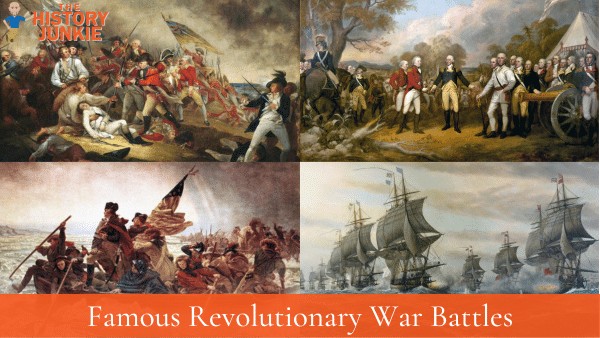
The Revolutionary War would be fought differently than prior wars in Europe. While George Washington would raise a professional army, every battle would be fought alongside and sometimes exclusively with militia.
The lack of a professional army and navy would be an obstacle that the leadership during the war would have to learn to work with and around. It would be an advantage in some battles and a complete disaster in others.
Jump to:
- #1. Battles of Lexington and Concord
- #2. Battle of Bunker Hill
- #3. The Capture of Fort Ticonderoga
- #4. Battle of Quebec
- #5. The Battle of Long Island
- #6. The Battle of White Plains
- #7. The Battle of Fort Washington
- #8. The Battle of Trenton
- #9. The Battle of Princeton
- #10. The Battle of Hubbardton
- #11. The Battle of Bennington
- #12. The Battle of Brandywine
- #13. The Battle of Germantown
- #14. The Battle of Saratoga
- #15. The Battle of Monmouth
- #16. The Battle of Rhode Island
- #17. The Siege of Savannah
- #18. Battle of Vincennes
- #19. Sullivan's Expedition
- #20. The Battle of Flamborough Head
- #21. The Siege of Charleston
- #22. The Battle of Waxhaws
- #23. The Battle of Camden
- #24. The Battle of King's Mountain
- #25. The Battle of Cowpens
- #26. The Battle of Guilford Courthouse
- #27. The Battle of the Chesapeake
- #28. The Battle of Eutaw Springs
- #29. Siege of Yorktown
- #30. The Battle of Fallen Timbers
#1. Battles of Lexington and Concord
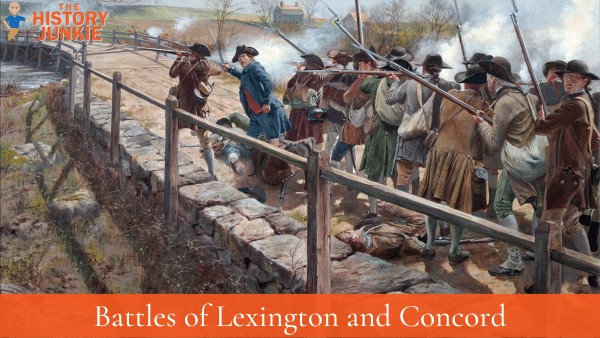
The Battles of Lexington and Concord were technically two separate battles, but they were linked together because they took place on the same day.
The Battle of Lexington was a skirmish between Minutemen on the Lexington Greene and the Marching British soldiers. The British had plans to confiscate the ammunition that was being held at Concord. Joseph Warren learned about this plan and then organized Paul Revere and William Dawes to alarm the countryside.
Also Read: Facts about Lexington and Concord
Thomas Gage knew that the patriots in Boston were well organized and had something in place because months earlier, they had accidentally triggered the alarm system with an event known as the Powder Alarm. He did not know how sophisticated the alarm system was.
Also Read: Paul Revere's Ride to learn about the complexity of the alarm system.
By the time the British arrived at Lexington, word had already reached Concord and the surrounding areas. There was some initial chaos that occurred due to poor leadership from John Pitcairn, which resulted in a shot being fired from one of the sides. The Lexington men scattered, and the British were brought under control by their commander, Francis Smith.
They continued their march to Concord, where they were met with stiff resistance from Josiah Bartlett and the men of Concord. They were driven back and forced to retreat back to Boston.
Also Read: Why The British Lost Lexington and Concord
During their retreat, the provincials from surrounding areas continued to swarm as the day went on. Their numbers grew as the British numbers continued to dwindle. The British army almost saw the complete defeat of their force, but great timing from Lord Percy helped support the retreat.
After the battle was over, the British troops in Boston were surrounded, and a siege was put into place.
#2. Battle of Bunker Hill
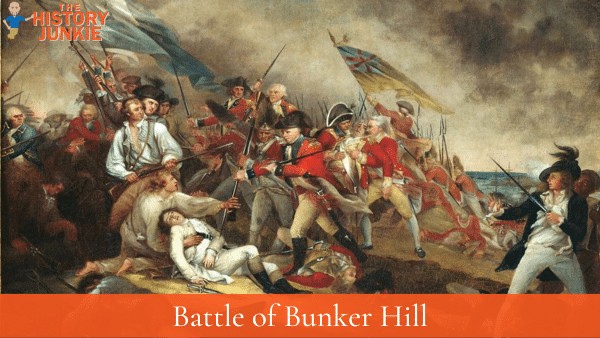
With the siege in place, the British were confined to the city or the Atlantic Ocean. Within two months, the British sent fresh men and commanders to help lift the siege. These men were under Sir William Howe, who had sympathies toward the rebellion but always put duty to the country over his personal beliefs.
In order to lift the siege, he planned a frontal assault on Breed's Hill, where the colonists were entrenched. He had no idea the strength of their resolve and what would occur.
Also Read: 20 Battle of Bunker Hill Facts That Changed America
On the morning of June 17, 1775, he ordered the British to attack, and they began their disciplined march up the hill where the patriots waited.
On the patriot side, they were led by William Prescott and Israel Putnam. Israel Putnam had given orders to the men to hold their fire until they could see the whites in their eyes. This was important because Revolutionary War muskets were notoriously inaccurate.
Also Read: Weapons of the Revolutionary War
The British made their first ascent, and the colonists waited patiently. As the British neared the entrenched militia, the colonists pointed, aimed, and then fired when the British were near. The volley was devastating, and it pushed the British back.
They regrouped and ascended again and again. They were met with stiff resistance and pushed back. They then mounted a third assault on Breed's Hill, and the lack of ammunition forced the patriots to retreat.
During the retreat, Joseph Warren was killed.
The British won the Battle of Bunker Hill, but the spoils were non-existent. They did not break the siege and instead lost 1,000 men in the battle.
#3. The Capture of Fort Ticonderoga
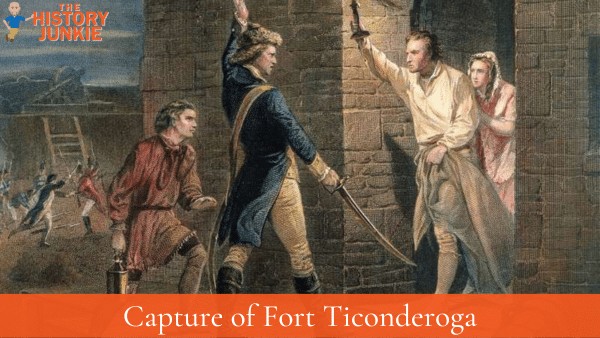
Fort Ticonderoga was a strategic fort during the French and Indian War and was strategic at the beginning of the Revolutionary War.
Who came up with the idea to capture the fort is up for debate, but both Benedict Arnold and Ethan Allen believed they could capture the fort. Ethan Allen was the leader of the Green Mountain Boys, while Benedict Arnold was a Continental Officer who raised his own men.
Both met, and there was a dispute over who would lead. In the end, it would be given to Ethan Allen.
The men surrounded the fort, and Ethan Allen demanded that the commander of the fort surrender. Those staying at the fort had no idea a war had even begun and were not prepared to defend it.
This would result in the Continental Army acquiring much-needed ammunition and heavier weapons.
The guns of Fort Ticonderoga would be used to dislodge the British from Boston when, under the guidance of Henry Knox, they were moved from the fort to Dorchester Heights.
It would also serve as the starting point for the Invasion of Canada it did not have great results.
Ethan Allen would receive all the credit, and Benedict Arnold would be slighted. His eventual betrayal of his country ensured that he would not be remembered for his contributions at Ticonderoga.
#4. Battle of Quebec
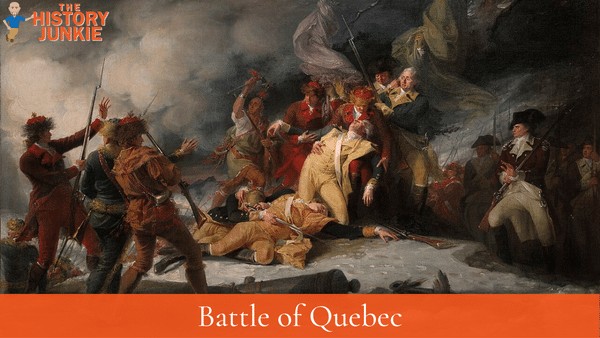
The Battle of Quebec was the final battle during the Invasion of Canada.
The Continental Congress initially rejected the idea of invading Quebec but eventually authorized Major General Philip Schuyler, the commander of the Northern Department, to invade the province if he felt it necessary. On June 27, 1775, Schuyler received approval for the invasion.
As part of an American propaganda offensive, letters from Congress and the New York Provincial Assembly were circulated throughout Quebec, promising liberation from British rule.
Benedict Arnold, who had been passed over for command of the main invasion force, convinced General George Washington to authorize a second expedition through the wilderness of what is now the state of Maine directly to Quebec City, the capital of the province.
The plan approved by Congress called for a two-pronged attack: 3,000 men under Schuyler would march up Lake Champlain and the Richelieu River valley to take Montreal, while 1,050 men under Arnold would march up the Kennebec River valley, over the Height of Land, and then down the Chaudière River valley to take Quebec City.
Richard Montgomery would take control of Schuyler's men to lead the attack of the first prong. It was believed that the Canadiens would side with the colonists and push back against British rule. This belief was held due to the conflict that had occurred after the French and Indian War when Britain took control of the Canadian colonies.
There had been several conflicts between the Catholics and Protestants in the region, but those issues had been resolved with the Quebec Act.
The Continental Army easily captured Montreal and then set its eyes on the Crown Jewel of Quebec. If they captured Quebec, then they would have control of Canada.
The attack would fall short and result in the death of Richard Montgomery. They would never try to invade Canada again.
#5. The Battle of Long Island
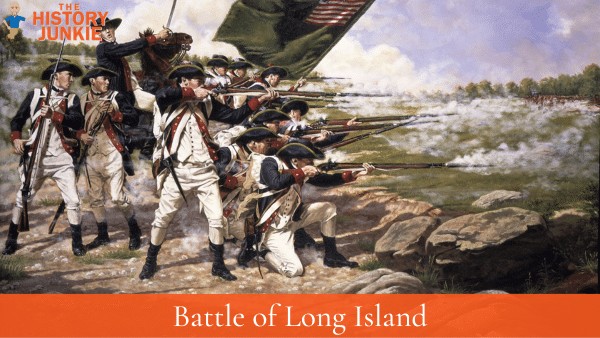
The British had been embarrassed in Boston, and retreating from the city, they began to develop plans to invade the colonies and bring them to their knees. Their target was New York.
New York was the most important harbor in the colonies, giving them access to waterways they could use to maneuver through the colonies. It was also helpful that the colonies did not have a formidable navy and, therefore, could not stop the progress of the British.
After defeating the British in Boston, General George Washington moved his army to New York City to defend it from the British. The British landed on Staten Island in July and were reinforced by a fleet of ships in Lower New York Bay.
Washington knew that it would be difficult to hold the city with the British fleet in control of the harbor, so he moved most of his forces to Manhattan.
On August 21, the British landed on the shores of Gravesend Bay, more than a dozen miles south of Manhattan. After five days, they attacked the American defenses on Guan Heights. The Americans were caught off guard and suffered heavy casualties.
A stand by 400 Maryland and Delaware troops prevented even greater losses. The remaining American forces retreated to Brooklyn Heights.
The British dug in for a siege, but Washington evacuated the entire army to Manhattan on the night of August 29-30.
#6. The Battle of White Plains
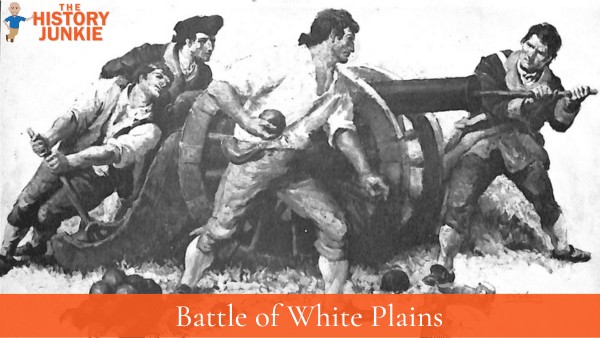
The Battle of White Plains took place on October 28, 1776. The Continental Army, led by General George Washington, was retreating northward from New York City when they were attacked by British forces led by General William Howe.
This would be an attack in which many Hessians were involved.
The British were able to drive the Americans from a hill near the village of White Plains, and Washington was forced to retreat his forces farther north.
The Battle of White Plains was a tactical victory for the British, but it did not lead to a decisive outcome in the war.
General Howe and General Washington remained in their positions for two days. Howe reinforced his position on Chatterton Hill while Washington prepared his army for retreat.
On October 30, Howe received additional troops from Lord Percy and planned to attack the Americans the following day. However, heavy rain fell, preventing Howe from acting. When the rain finally stopped, Howe found that Washington had already retreated to the hills to the north.
Howe chose not to follow Washington, instead attempting to draw him out. However, Washington was able to evade Howe's forces.
On November 5, Howe turned his attention to Manhattan.
#7. The Battle of Fort Washington
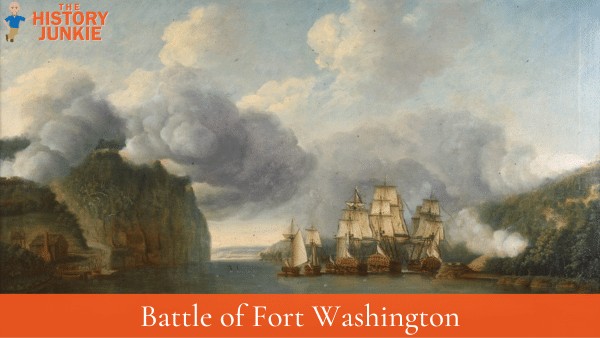
The Battle of Fort Washington took place on November 16, 1776, in New York City.
The British forces, led by Lieutenant General William Howe, defeated the Continental Army, which was commanded by General George Washington. The battle was one of the worst defeats for the Americans during the war.
The British had been planning to capture Fort Washington, the last American stronghold on Manhattan since they defeated the Continental Army at the Battle of White Plains.
General Washington had ordered General Nathanael Greene to abandon the fort and move its garrison to New Jersey, but Colonel Robert Magaw, who was in command of the fort, refused to do so. He believed that the fort could be defended from the British.
On November 16, Howe launched a three-pronged attack on the fort. The British forces attacked from the north, east, and south. The tides in the Harlem River prevented some of the British troops from landing, which delayed the attack.
However, the British forces eventually overwhelmed the American defenses. The southern and western American defenses fell quickly, and the Patriot forces on the north side offered stiff resistance, but they, too, were eventually defeated. With the fort surrounded by land and sea, Colonel Magaw surrendered.
The Battle of Fort Washington was a major defeat for the Americans. They lost 59 men killed in action and 2,837 men taken prisoner.
The loss of the fort was a blow to American morale, forcing Washington to retreat from Manhattan.
The loss also damaged Nathanael Greene and George Washington's relationship for a short period of time.
#8. The Battle of Trenton
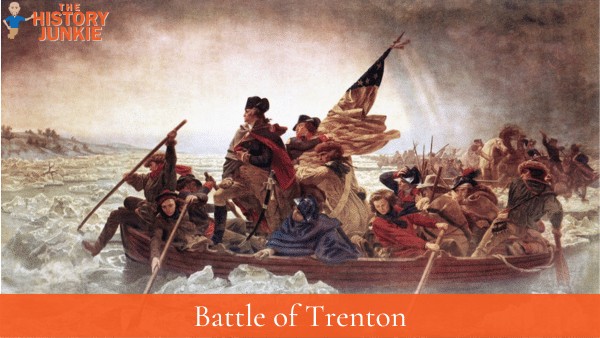
The Battle of Trenton took place on December 26, 1776, in Trenton, New Jersey. The Continental Army, led by General George Washington, crossed the Delaware River in the dead of night and attacked a Hessian garrison that was unprepared for battle.
The Americans won a decisive victory, capturing nearly 1,000 Hessians and boosting morale in the Continental Army.
The Continental Army had been suffering a series of defeats in New York and had been forced to retreat to Pennsylvania. Morale was low, and many soldiers were considering deserting. Washington knew that he needed a victory to turn the tide of the war.
On the night of December 25, Washington led his army across the Delaware River in freezing temperatures. The crossing was dangerous, and two detachments were unable to make it.
The remaining 2,400 men marched 9 miles to Trenton, where they surprised the Hessian garrison.
The Hessians were caught off guard and were quickly defeated. Nearly 1,000 Hessians were captured, and only a few hundred escaped. The victory was a major morale boost for the Continental Army and inspired many soldiers to re-enlist.
The Battle of Trenton was a turning point in the American Revolutionary War. It showed that the Continental Army could still win battles, and it gave hope to the American people.
The victory helped to turn the tide of the war in favor of the Americans.
#9. The Battle of Princeton
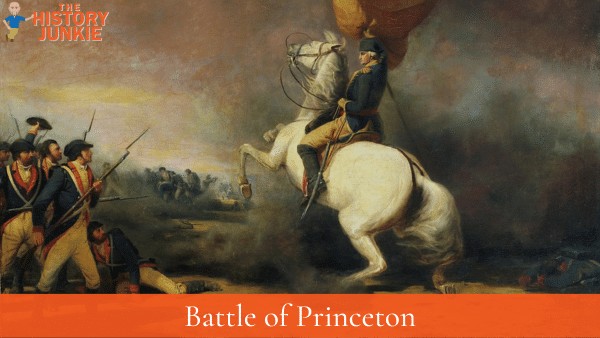
The Battle of Princeton took place on January 3, 1777, near Princeton, New Jersey. The battle was a small victory for the Continental Army, led by General George Washington.
After defeating the Hessians at the Battle of Trenton on December 26, 1776, Washington decided to attack the British forces in New Jersey before going into winter quarters. He crossed the Delaware River on December 30 and marched his army to Princeton.
On January 3, Washington's army clashed with a British force led by Lieutenant Colonel Charles Mawhood. The Americans were initially defeated, and Brigadier General Hugh Mercer was mortally wounded. However, Washington rallied his troops and led a counterattack that drove the British back.
The British retreated to Princeton, where they were pursued by the Americans. Some British troops took refuge in Nassau Hall, but they were eventually forced to surrender.
The Battle of Princeton was a small victory for the Americans, but it was a major morale boost. It showed that the Continental Army could still win battles, and it helped to convince many Americans that the war could be won.
The battle also had a strategic impact. It forced the British to evacuate Central Jersey, and it gave Washington the time he needed to regroup his army and prepare for future battles.
#10. The Battle of Hubbardton
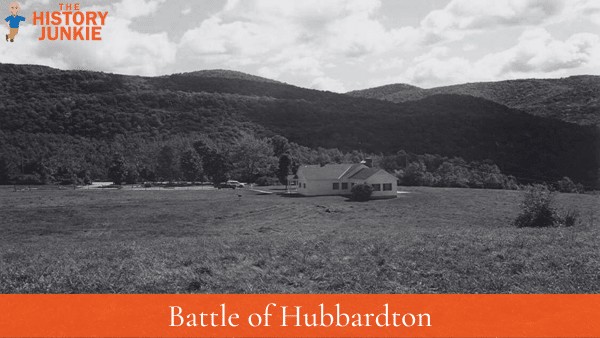
The Battle of Hubbardton took place on July 7, 1777, in Hubbardton, Vermont. The battle was fought between American and British forces.
The American forces were led by General Seth Warner, and the British forces were led by General Simon Fraser.
The Americans were retreating from Fort Ticonderoga, which had been captured by the British.
The British forces caught up with the American rear guard at Hubbardton and attacked them.
The Americans were initially surprised by the attack, but they fought bravely. They were eventually forced to retreat, but they inflicted heavy casualties on the British forces.
The British forces did not pursue the Americans further, as they had suffered too many casualties themselves.
The Battle of Hubbardton was a tactical victory for the British, but it was a strategic victory for the Americans. The forces that escaped the British would fight against them later in the campaign.
#11. The Battle of Bennington
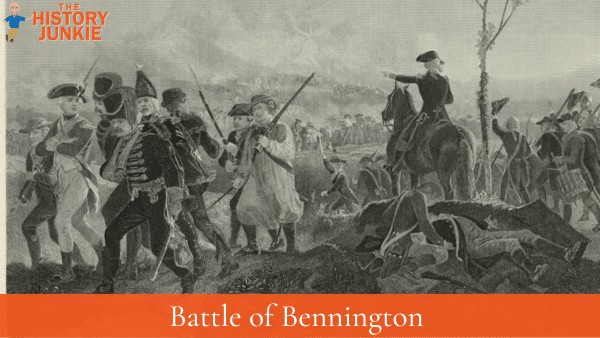
The Battle of Bennington took place on August 16, 1777, when a force of 2,000 American militiamen, led by General John Stark, defeated a detachment of 700 British and German soldiers led by Lieutenant Colonel Friedrich Baum.
Baum's detachment was sent by British General John Burgoyne to raid Bennington, Vermont, for supplies. However, the Americans were waiting for them.
After a standoff caused by rain, Stark's men attacked and surrounded Baum's position. They took many prisoners and killed Baum himself.
Reinforcements arrived for both sides, but the Americans were victorious. They drove off Breymann's reinforcements and killed or captured many of the British and German soldiers.
The Battle of Bennington was a major strategic victory for the Americans. It reduced Burgoyne's army by almost 1,000 men, deprived him of much-needed supplies, and led his Native American supporters to abandon him. These factors all contributed to Burgoyne's eventual defeat at Saratoga.
The victory at Bennington also had a significant impact on the war overall. It boosted American morale and convinced France to enter the war on the side of the Americans.
The battle is still celebrated today in the state of Vermont as Bennington Battle Day.
#12. The Battle of Brandywine
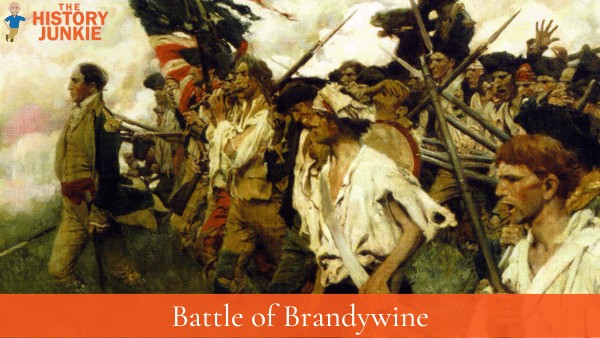
The Battle of Brandywine was a battle of the American Revolutionary War that took place on September 11, 1777, between the American Continental Army under General George Washington and the British Army under General Sir William Howe.
The battle was fought near Chadds Ford, Pennsylvania, and was the largest battle of the war, with over 30,000 troops participating.
The British forces were victorious, routing the Continental Army and forcing them to withdraw to Chester, Pennsylvania. The British then captured Philadelphia, the American capital, two weeks later.
The British victory at Brandywine was due in part to their superior numbers and strategy. Howe outmaneuvered Washington by sending a large force to flank the American right flank.
The Americans were caught off guard and were unable to defend themselves against the British attack.
The Battle of Brandywine also showed the importance of scouting. The Americans were not aware of Howe's flanking maneuver until it was too late. If they had had better intelligence, they might have been able to defeat the British.
The Battle of Brandywine was a costly victory for the British. They suffered over 1,000 casualties, while the Americans suffered over 2,000 casualties. However, the British were able to achieve their strategic objective of capturing Philadelphia.
Despite the strategic success, it left General John Burgoyne vulnerable at Saratoga.
#13. The Battle of Germantown
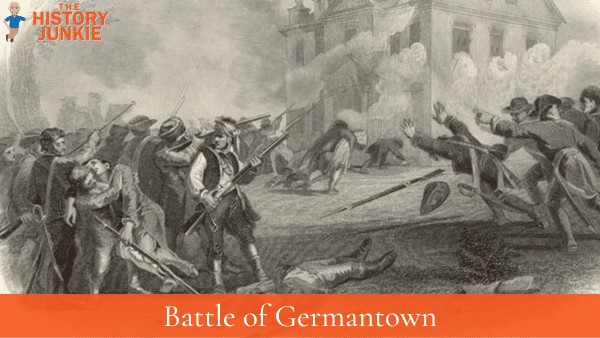
The Battle of Germantown was fought on October 4, 1777.
The British had recently defeated the Americans at the Battles of Brandywine and Paoli, and they had taken control of Philadelphia. However, the British forces were divided, with a large contingent stationed in Germantown.
General George Washington saw an opportunity to attack the British at Germantown and defeat them in a surprise attack. He divided his army into four columns and planned to converge on the British position from all sides.
The attack began well, with the Americans routing the British pickets. However, a heavy fog caused confusion among the Americans, and they were unable to coordinate their attacks.
One of the American columns, led by General John Sullivan, attacked the Chew House, a fortified British position. The Americans were unable to take the house, and they suffered heavy casualties.
Another American column, led by General Anthony Wayne, collided with another American column in the fog. The two columns opened fire on each other, believing that they were under attack by the British.
By the end of the day, the Americans had been defeated. However, the battle was not a complete loss for the Americans. The French government, impressed by the American victory at Saratoga, decided to provide more aid to the Americans.
The British, for their part, did not pursue the defeated Americans. Instead, they turned their attention to clearing the Delaware River of obstacles. After unsuccessfully attempting to draw Washington into battle at White Marsh, the British withdrew to Philadelphia.
Washington, his army intact, withdrew to Valley Forge, where he wintered and re-trained his forces.
#14. The Battle of Saratoga
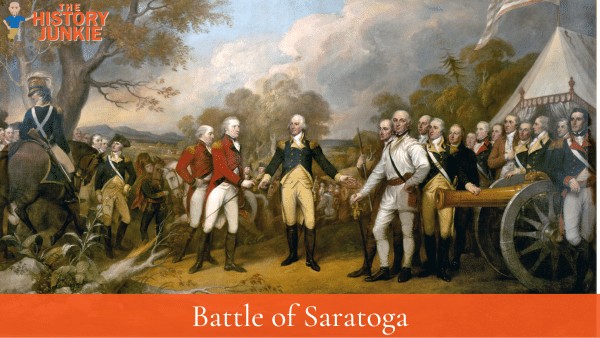
The Battles of Saratoga were a turning point in the Revolutionary War.
In September and October 1777, British General John Burgoyne led an invasion army southward from Canada, hoping to meet a similar British force marching northward from New York City and another British force marching eastward from Lake Ontario.
However, the Southern and Western forces never arrived, and Burgoyne was surrounded by American forces in upstate New York.
The first battle, the Battle of Freeman's Farm, took place on September 19. Burgoyne won a small tactical victory but at the cost of significant casualties.
He attacked the Americans again in the Battle of Bemis Heights on October 7. At this point, General Horatio Gates was in a well-fortified position, which made it difficult for the British to take.
Despite the advantage, the battle shifted in favor of the British, and it would take a spirited rally from Benedict Arnold to drive the British back.
This time, the Americans were victorious, and Burgoyne was forced to retreat.
With his army surrounded by a much larger American force, Burgoyne surrendered on October 17.
His surrender was a major victory for the Americans, and it helped to convince France to enter the war on their side. They aided Benjamin Franklin, who was negotiating
Not all was good for the Americans. Benedict Arnold had his leg shot and crushed, which would force him into recovery.
During this time, Horatio Gates would take all of the glory of the battle and not mention Arnold. This would be the second slight to Arnold, and it would be the last time he ever fought on the side of the Americans.
If the bullet had traveled a little higher and killed Arnold, he would be remembered as the hero of Saratoga but instead became the most notorious traitor.
#15. The Battle of Monmouth
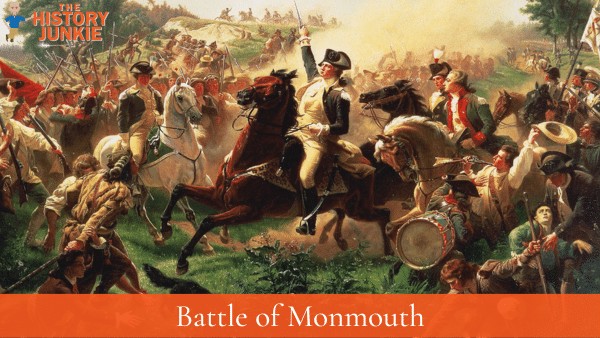
The Battle of Monmouth took place on June 28, 1778, in Freehold Borough, New Jersey.
The battle was fought between the Continental Army, commanded by General George Washington, and the British Army in North America, commanded by General Sir Henry Clinton.
The battle began badly for the Americans when General Charles Lee botched an attack on the British rearguard at Monmouth Court House.
A counter-attack by the main British column forced Lee to retreat until Washington arrived with the main body. Clinton disengaged when he found Washington in an unassailable defensive position and resumed the march to Sandy Hook.
The battle was tactically inconclusive and strategically irrelevant; neither side landed the blow they hoped to on the other. Washington's army remained an effective force in the field, and the British redeployed successfully to New York.
Both sides sustained considerable casualties, though the majority were from heat-related illness and exhaustion rather than combat.
The Continental Army is estimated to have inflicted more losses than it received, and it was one of the rare occasions on which it retained possession of a battlefield.
It had proven itself to be much improved after the training it underwent over the winter, and the professional conduct of the American troops during the battle was widely noted by the British.
Washington was able to present the battle as a triumph, and he voted a formal thanks by Congress to honor "the important victory of Monmouth over the British grand army."
His position as commander-in-chief became unassailable. He was lauded for the first time as the father of his country, and his detractors were silenced.
Lee was vilified for his failure to press home the attack on the British rearguard. Because of his tactless efforts to argue his case in the days after the battle, Washington had him arrested and court-martialed on charges of disobeying orders, conducting an "unnecessary, disorderly, and shameful retreat," and disrespect towards the commander-in-chief.
Lee made the fatal mistake of turning the proceedings into a contest between himself and Washington. He was found guilty on all counts, although his culpability on the first two charges was debatable.
#16. The Battle of Rhode Island
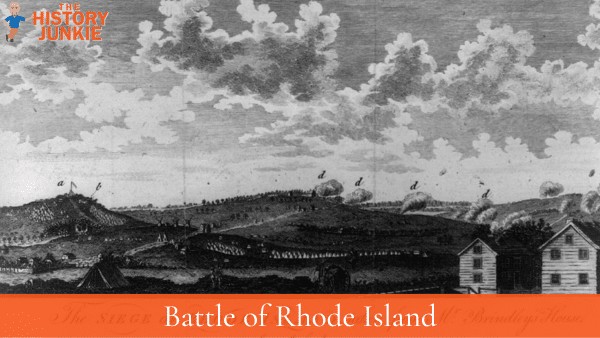
The Battle of Rhode Island took place on August 29, 1778.
The battle was fought between Continental Army and Militia forces under the command of Major General John Sullivan and British forces under the command of Major General Robert Pigot.
The battle took place after the Continental Army and Militia had been besieging the British forces in Newport, Rhode Island, for several weeks.
The Americans had finally abandoned their siege and were withdrawing to the northern part of the island when the British forces sortied, supported by recently arrived Royal Navy ships.
The British attacked the retreating Americans, but the battle ended inconclusively. The Continental forces withdrew to the mainland and left Aquidneck Island in British hands.
The battle was the first attempt at cooperation between French and American forces following France's entry into the war as an American ally.
Operations against Newport were planned in conjunction with a French fleet and troops, but they were frustrated in part by difficult relations between the commanders, as well as by a storm that damaged both French and British fleets shortly before joint operations were to begin.
The battle was also notable for the participation of the 1st Rhode Island Regiment under the command of Colonel Christopher Greene, which consisted of Africans, American Indians, and White colonists.
The regiment fought bravely in the battle and helped to blunt the British attack.
#17. The Siege of Savannah
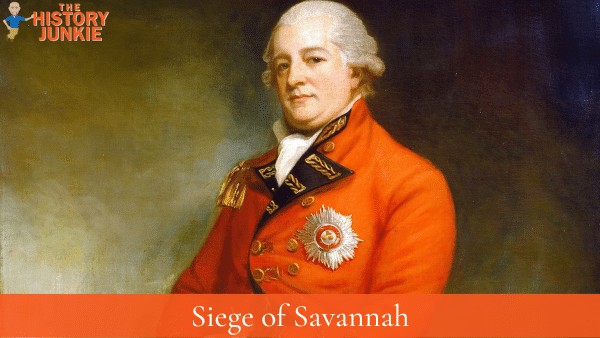
The Capture of Savannah took place on December 29, 1778. The battle was fought between local American Patriot militia and Continental Army units, holding the city against a British invasion force commanded by Lieutenant Colonel Archibald Campbell.
The British victory in Savannah gave the British control of a major city in the South and boosted morale among Loyalists in the region. The British were able to hold onto Savannah until late in the war, despite several attempts by the Americans to retake the city.
The British strategy in the South was to appeal to the relatively strong Loyalist sentiment in the region. They hoped that by capturing key cities and towns, they could convince more Loyalists to come out of hiding and support the British cause. The capture of Savannah was a major step in this strategy.
The battle itself was short and bloody. The British forces attacked the American positions outside the city and quickly overwhelmed them. The Americans were forced to retreat, and the British took control of the city.
The British victory in Savannah had a number of negative consequences for the Americans. It gave the British control of a major city in the South, which boosted morale among Loyalists and discouraged Patriots.
It also gave the British a base of operations from which they could launch attacks on other parts of the South.
The British were able to hold onto Savannah until late in the war, but they were never able to consolidate their control of the region fully.
#18. Battle of Vincennes
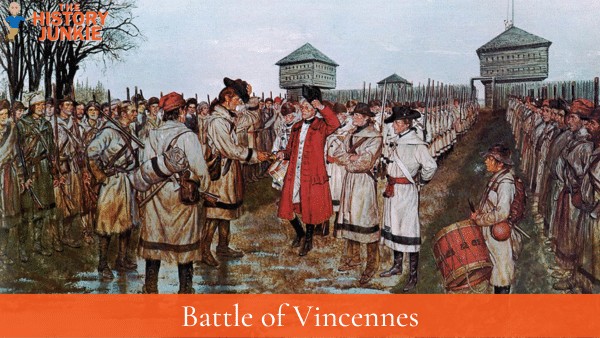
The Battle of Vincennes was a frontier battle fought in present-day Vincennes, Indiana, won by a militia led by American commander George Rogers Clark over a British garrison led by Lieutenant Governor Henry Hamilton.
Roughly half of Clark's militia were Canadian volunteers sympathetic to the American cause.
After a daring wintertime march, the small American force was able to force the British to surrender the fort and, in a larger frame, the Illinois territory.
The battle took place in February 1779. Clark's forces traveled over 180 miles in the dead of winter to surprise the British garrison at Fort Vincennes.
The British were outnumbered and outgunned, and they surrendered after a brief battle.
The Siege of Fort Vincennes is considered to be one of George Rogers Clark's greatest victories. It was a daring and risky operation, but it paid off handsomely.
Clark's victory was celebrated by General George Washington and the Continental Congress.
It helped to encourage the alliance with France, which provided much-needed military and financial support to the American cause.
Clark's success also had a lasting impact on the political landscape of the United States. Virginia claimed the whole of the Old Northwest in the aftermath of the victory, and in 1781, it ceded the region to the central government.
These lands eventually became the Northwest Territory of the United States.
#19. Sullivan's Expedition
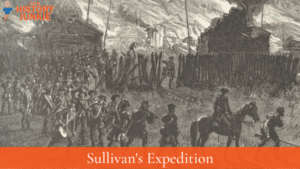
The Sullivan Expedition was a military campaign carried out by the Continental Army. The goal of the campaign was to "take the war home to the enemy to break their morale."
The expedition was ordered by George Washington in response to the 1778 Iroquois–British attacks on Wyoming, German Flatts, and Cherry Valley, where the Iroquois and British massacred American villagers.
The expedition was largely successful, with more than 40 Iroquois villages and their stores of winter crops destroyed. This broke the power of the Iroquois in New York all the way to the Great Lakes.
The campaign drove 5,000 Iroquois to Fort Niagara, seeking British protection.
The Sullivan Expedition had a significant impact on the Iroquois people. It destroyed their villages and crops, and it forced them to flee their homeland.
The expedition also opened up the Ohio Country, the Great Lakes region, and other parts of the frontier to American settlement.
#20. The Battle of Flamborough Head
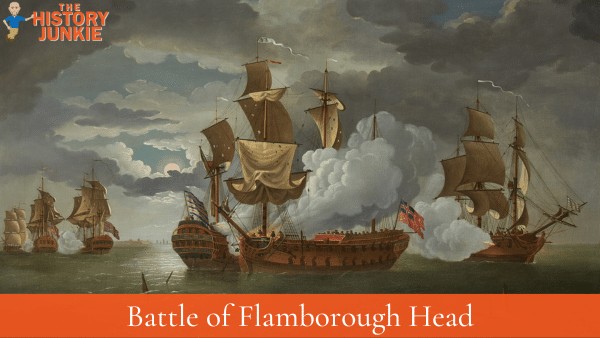
The Battle of Flamborough Head was a naval battle that took place on September 23, 1779, in the North Sea off the coast of Yorkshire between a combined Franco-American squadron, led by Continental Navy officer John Paul Jones, and two British escort vessels protecting a large merchant convoy.
The American squadron consisted of the frigate USS Bonhomme Richard, the brigantine USS Alliance, and the ketch USS Pallas. The British squadron consisted of the 44-gun frigate HMS Serapis and the 20-gun brig HMS Countess of Scarborough.
The battle began when Jones' squadron encountered the British convoy off Flamborough Head. Jones ordered his ships to attack the Serapis while the Countess of Scarborough fled. The Bonhomme Richard and the Serapis fought a close-range battle for over two hours.
Both ships were badly damaged, and the Bonhomme Richard was eventually dismasted. However, Jones refused to surrender, and the battle continued until nightfall. In the darkness, the Countess of Scarborough escaped.
The next morning, the Bonhomme Richard was sinking, and Jones ordered his crew to abandon the ship. The Serapis was also badly damaged, but it was able to limp back to port.
The Battle of Flamborough Head was a victory for Jones, even though he lost his ship.
The battle showed that American ships could compete with British ships, and it boosted morale among the American people. The battle also made Jones a national hero.
#21. The Siege of Charleston
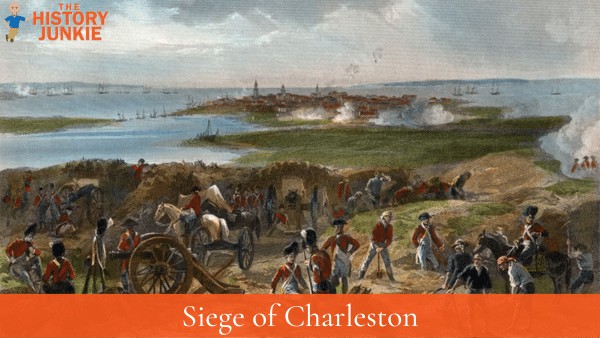
The Siege of Charleston was a major engagement and major British victory in the American Revolutionary War, fought in Charleston, the capital of South Carolina, between March 29 and May 12, 1780.
The British, following the collapse of their northern strategy in late 1777 and their withdrawal from Philadelphia in 1778, shifted their focus to the Southern Colonies.
The British army, commanded by Lieutenant General Henry Clinton, landed at Charleston on March 29, 1780, and began to lay siege to the city.
The American garrison, commanded by Major General Benjamin Lincoln, was outnumbered and outgunned. After approximately six weeks of siege, Lincoln surrendered his forces to Clinton on May 12, 1780. It was one of the worst American defeats of the war.
The Siege of Charleston had a number of negative consequences for the American side.
The British captured a significant amount of military hardware and supplies from the Americans during the Siege of Charleston. They captured 5,266 prisoners, 311 artillery pieces, 9,178 artillery rounds, 5,916 muskets, 33,000 rounds of ammunition, 15 Regimental colors, 49 ships, and 120 boats, plus 376 barrels of flour, and large magazines of rum, rice, and indigo.
Following the surrender, the captured ordnance was brought to a powder magazine. A Hessian officer warned that some of the guns might still be loaded, but he was ignored. One of the guns prematurely fired, detonating 180 barrels of powder, further discharging 5,000 muskets in the magazine. The accident killed approximately 200 people and destroyed six houses.
The prisoners of the siege were diverted to multiple locations, including prison ships, the old barracks where the College of Charleston is today (two barracks buildings are shown on early maps of the campus), and the Old Exchange and Provost "Dungeon."
Prison hulks awaited the majority of the 2,571 Continental prisoners, while parole was granted to the militia and civilians who promised not to take up arms. This ended the power of the American army in the South.
#22. The Battle of Waxhaws
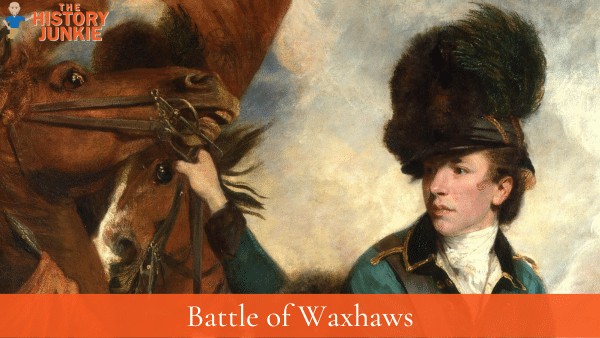
The Battle of Waxhaws was a military engagement that took place on May 29, 1780, between a Patriot force led by Abraham Buford and a British force led by Banastre Tarleton near Lancaster, South Carolina.
Buford's men consisted of Continental Army soldiers, while Tarleton's force was mostly made up of Loyalist troops. After the two forces sighted each other, Buford rejected an initial demand to surrender.
Tarleton's cavalrymen launched a charge against the Patriot troops, which led many of Buford's men to throw their arms down in surrender.
However, as Tarleton was shot under his horse during the charge, his infuriated soldiers attacked their Patriot opponents, killing several.
Of the 420 soldiers serving under Buford during the battle, 113 were killed, 150 were injured, and 53 were captured. The British suffered 5 men killed and 12 wounded.
Patriots subsequently coined the term "Tarleton's quarter" to refer to the practice of giving no quarter during battles, though he had not ordered his men to attack the surrendering Patriots.
In subsequent engagements in the Carolinas, it became rare for either side to take significant prisoners.
The battle became the subject of an intensive propaganda campaign by the Patriots to bolster recruitment and incite resentment against the British.
#23. The Battle of Camden
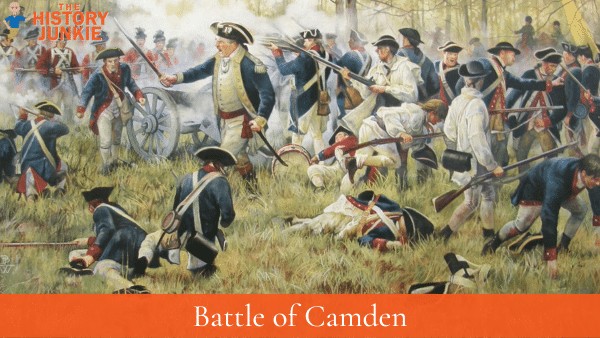
The Battle of Camden was a devastating defeat of the Patriot forces.
On August 16, 1780, British forces under Lieutenant General Charles Lord Cornwallis routed the numerically superior American forces led by Major General Horatio Gates about four miles north of Camden, South Carolina.
The rout was a personally humiliating defeat for Gates, the American general best known for commanding the Patriot forces at the British defeat at Saratoga three years previously.
His army had possessed a great numerical superiority over the British force, having twice the personnel. However, his command of them was seen as disorganized and chaotic.
Following the battle, he was regarded with disdain by his colleagues, and he never held a field command again. His political connections, however, helped him avoid any military inquiries or court martial into the debacle.
The battle began with the British forces attacking the American left flank. The Americans were initially successful in holding off the British attack, but they were eventually forced to retreat. The British forces then pursued the Americans and routed them.
The Battle of Camden led to the resignation of Horatio Gates and the promotion of Nathanael Greene.
#24. The Battle of King's Mountain
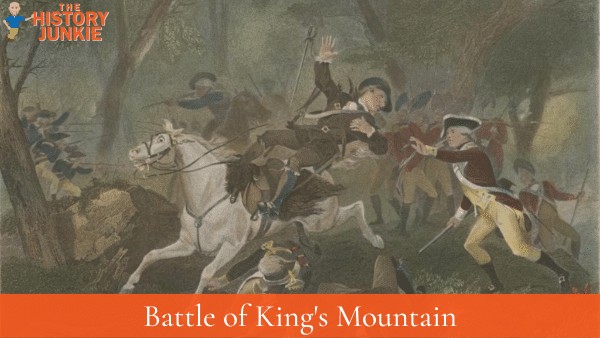
The Battle of Kings Mountain was a military engagement between Patriot and Loyalist militias in South Carolina during the Southern Campaign of the American Revolutionary War, resulting in a decisive victory for the Patriots.
The battle took place on October 7, 1780, 9 miles south of the present-day town of Kings Mountain, North Carolina. In what is now rural Cherokee County, South Carolina, the Patriot militia defeated the Loyalist militia commanded by British Major Patrick Ferguson of the 71st Foot.
The battle has been described as "the war's largest all-American fight."
Ferguson had arrived in North Carolina in early September 1780 to recruit troops for the Loyalist militia and protect the flank of Lord Cornwallis's main force.
Ferguson challenged Patriot militias to lay down their arms or suffer the consequences. In response, the Patriot militias led by Benjamin Cleveland, James Johnston, William Campbell, John Sevier, Joseph McDowell, and Isaac Shelby rallied to attack Ferguson and his forces.
Receiving intelligence on the oncoming attack, Ferguson decided to retreat to the safety of Lord Cornwallis's army. However, the Patriots caught up with the Loyalists at Kings Mountain near the border with South Carolina.
Achieving a complete surprise, the Patriot militiamen attacked and surrounded the Loyalists, inflicting severe casualties. After an hour of battle, Ferguson was fatally shot while trying to break the Patriot line, after which his men surrendered.
Some Patriots gave no quarter until their officers re-established control over their men; they were said to be seeking revenge for alleged killings by Banastre Tarleton's militiamen at the Battle of Waxhaws, under the slogan "Remember Tarleton's Quarter."
Although victorious, the Patriots had to retreat quickly from the area for fear of Cornwallis' advance. Later, they executed nine Loyalist prisoners after a short trial.
The battle was a pivotal event in the Southern campaign. The surprising victory of the American Patriot militia over the Loyalists came after a string of Patriot defeats at the hands of Lord Cornwallis and greatly raised the Patriots' morale.
With Ferguson dead and his Loyalist militia destroyed, Cornwallis was forced to abandon his plan to invade North Carolina and retreated into South Carolina.
#25. The Battle of Cowpens
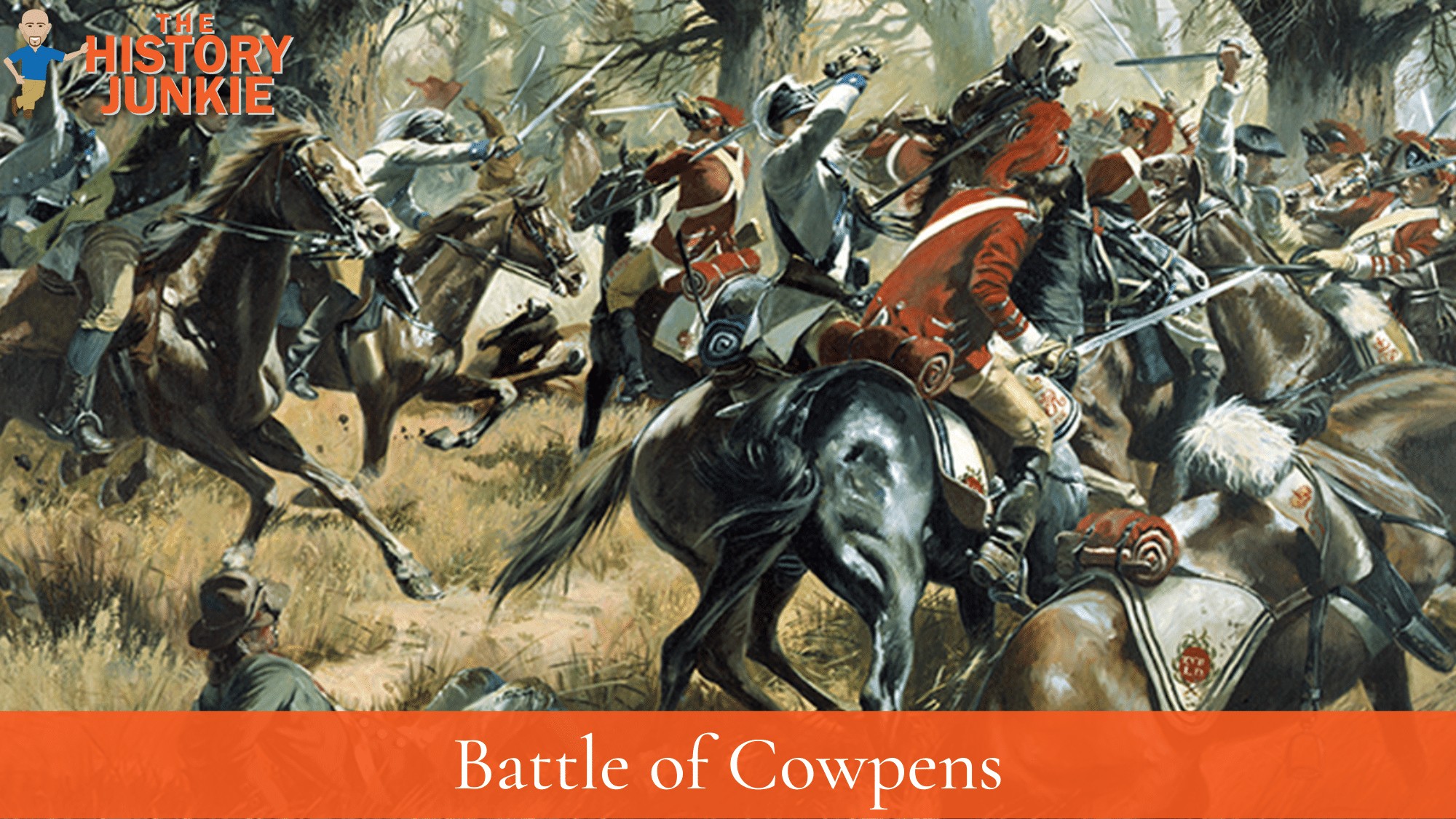
The Battle of Cowpens was a decisive victory for the American Patriots over the British in the American Revolutionary War. The battle took place on January 17, 1781, near the town of Cowpens, South Carolina.
The Patriot forces were led by Brigadier General Daniel Morgan, while the British forces were led by Lieutenant Colonel Banastre Tarleton.
Morgan's forces were outnumbered by the British, but they used a clever strategy to defeat them.
Morgan's forces divided their troops into three lines. The first line was made up of militiamen who were ordered to retreat after firing a few volleys.
The second line was made up of regulars who were ordered to hold their ground and fire at the British as they pursued the militiamen. The third line was made up of elite troops who were ordered to attack the British from the flank when they were most vulnerable.
The British fell for Morgan's trap. They pursued the militiamen, and as they did, they became disorganized and exhausted. The regulars in the second line opened fire on the British, and the elite troops in the third line attacked from the flank. The British were routed, and they suffered heavy casualties.
The Battle of Cowpens was a major turning point in the war. It showed that the Americans could defeat the British even when they were outnumbered.
It also led to the British abandoning their campaign in the Carolinas and eventually surrendering at Yorktown.
#26. The Battle of Guilford Courthouse
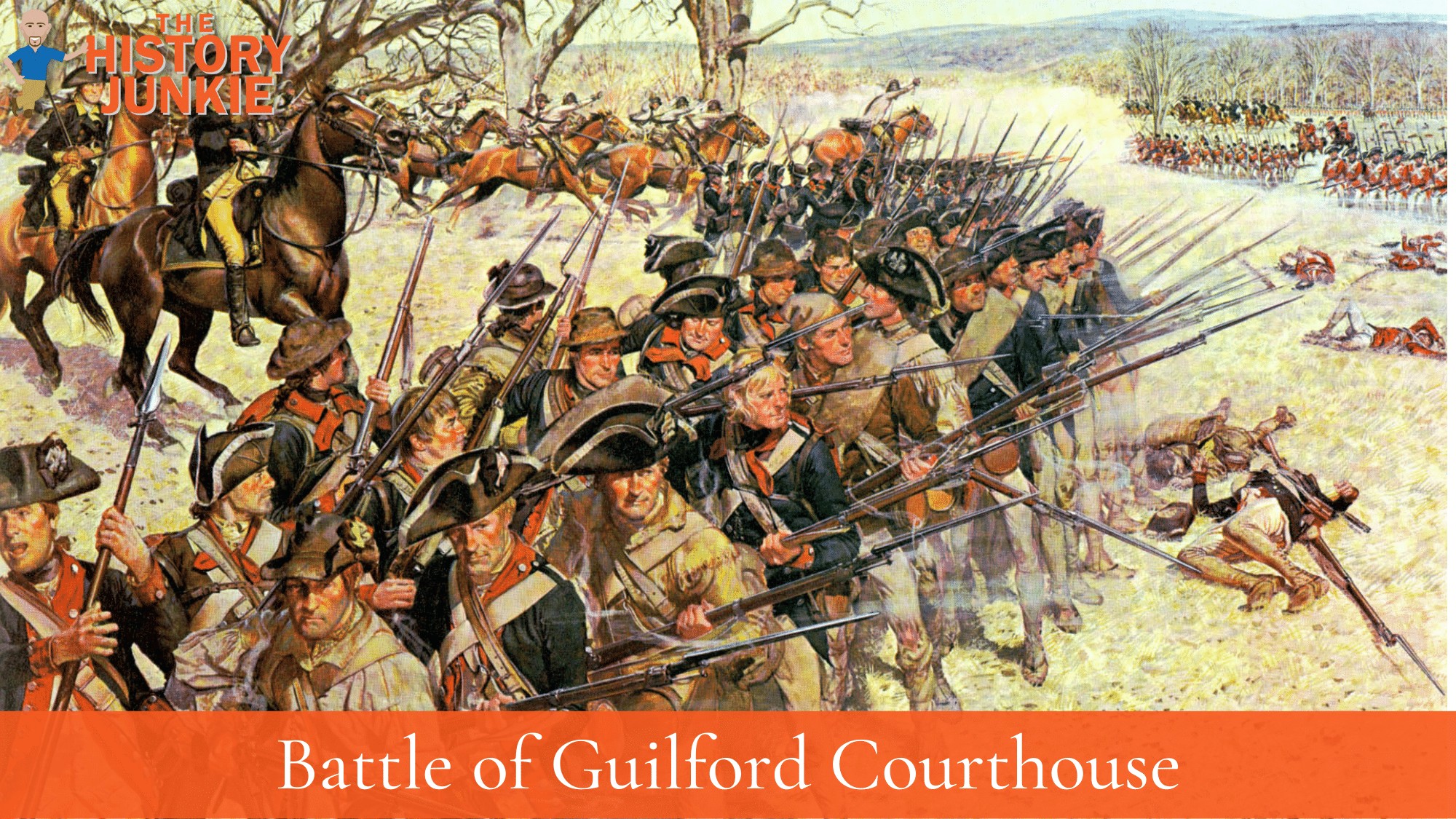
The Battle of Guilford Court House was a military engagement fought on March 15, 1781.
The battle took place in what is now Greensboro, North Carolina, and resulted in a tactical victory for the British forces under the command of Lieutenant General Charles Cornwallis.
However, the British suffered significant casualties, and the battle was considered to be a strategic victory for the American forces.
The battle took place after the British had achieved a string of successes in the Southern Theater of the war.
They had conquered much of Georgia and South Carolina with the aid of strong Loyalist factions, and they believed that North Carolina might be within their grasp.
However, the Battle of Guilford Court House put an end to their recruiting drive in North Carolina.
After the battle, the British forces under Cornwallis decided to march into Virginia in an attempt to link up with roughly 3,500 men under British Major General Phillips and American turncoat Benedict Arnold.
This decision proved to be a mistake, as it allowed the American forces under Nathanael Greene to unravel British control of the South
#27. The Battle of the Chesapeake
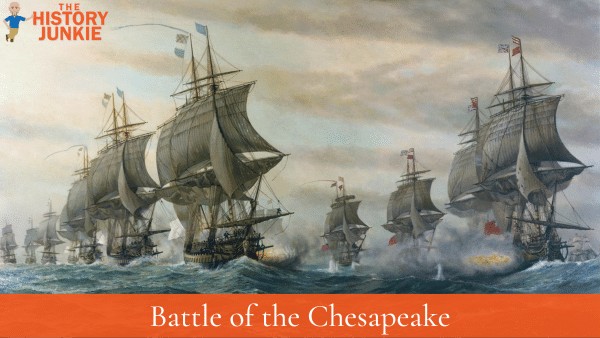
The Battle of the Chesapeake was a naval battle that took place on September 5, 1781, near the mouth of the Chesapeake Bay.
The battle was fought between a British fleet led by Rear Admiral Sir Thomas Graves and a French fleet led by Rear Admiral François Joseph Paul, the Comte de Grasse.
The battle was strategically decisive, as it prevented the British from reinforcing or evacuating their forces at Yorktown, Virginia.
This led to the surrender of British General Charles Cornwallis and his army at Yorktown, which effectively secured American independence.
The French fleet arrived in the Chesapeake Bay on August 30, 1781, and anchored off Cape Henry. The British fleet arrived on September 5 and engaged the French fleet in battle.
The battle lasted for about two hours and was inconclusive, with both sides suffering heavy casualties. However, the French fleet remained in control of the Chesapeake Bay, which prevented the British from reinforcing or evacuating Cornwallis's army at Yorktown.
#28. The Battle of Eutaw Springs
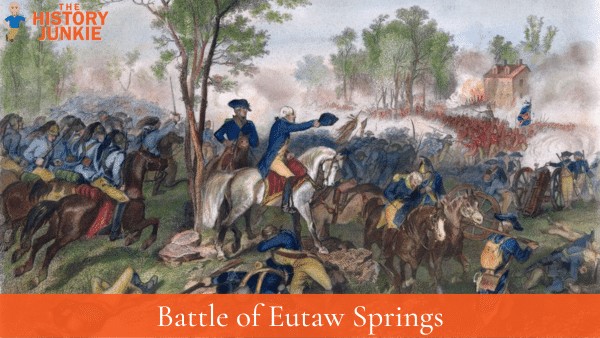
The Battle of Eutaw Springs was fought on September 8, 1781, near Eutaw Springs, South Carolina.
The American forces were led by Major General Nathanael Greene, while the British forces were led by Lieutenant Colonel Alexander Stewart. The battle began with the British attacking the American lines.
The Americans were initially forced back, but they were able to rally and drive the British back. The battle continued for several hours, with neither side able to gain an advantage.
After the Battle of Eutaw Springs, neither army left the vicinity for at least a full day. When Greene withdrew, he left a strong picket to oppose a possible British advance, while Stewart withdrew the remnants of his force towards Charleston.
His rear was apparently under constant fire, at least until meeting with reinforcements near Moncks Corner.
Despite winning a tactical victory, the British lost strategically. Their inability to stop Greene's continuing operations forced them to abandon most of their conquests in the South, leaving them in control of a small number of isolated enclaves at Wilmington, Charleston, and Savannah.
The British attempt to pacify the South with Loyalist support had failed even before Cornwallis surrendered at Yorktown.
#29. Siege of Yorktown
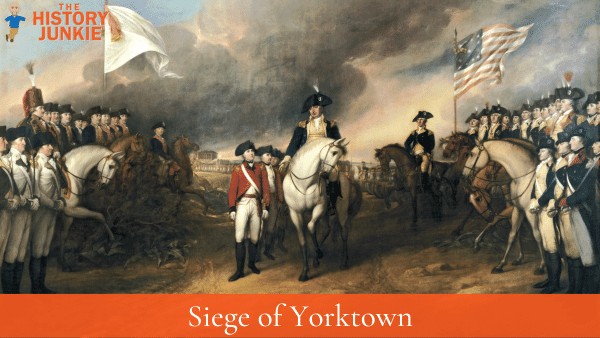
The Battle of Yorktown was a siege that took place in Yorktown, Virginia, from September 28 to October 19, 1781. The battle pitted American and French forces against British forces under the command of General Charles Cornwallis.
The battle was the culmination of a series of strategic moves by the Americans and French, who had managed to trap Cornwallis's army at Yorktown.
The French fleet, led by the Comte de Grasse, had secured control of the Chesapeake Bay, preventing the British from reinforcing or evacuating Cornwallis's army.
The American army, led by General George Washington, marched south from New York and joined forces with the French army outside Yorktown.
The siege began on September 28, 1781. The Americans and French dug trenches around Yorktown and bombarded the British fortifications. Cornwallis's army was outnumbered and outgunned, and he surrendered on October 19, 1781.
After the British surrender at Yorktown, the American and French officers entertained their defeated foes to dinner. The British officers were "overwhelmed" by the civility of their former enemies, with some French officers offering "profuse" sympathies for their defeat.
However, the French aide to Rochambeau, Cromot du Bourg, noted the coolness of the British officers, particularly O'Hara, considering the defeat they had endured.
Five days after the battle, on October 24, 1781, the British fleet sent by Clinton to rescue the British army arrived. The fleet picked up several provincials who had escaped on October 18, and they informed Admiral Thomas Graves that they believed Cornwallis had surrendered.
Graves picked up several more provincials along the coast, and they confirmed this fact. Graves sighted the French fleet but chose to leave because he was outnumbered by nine ships, and thus, he sent the fleet back to New York.
After the Battle of Yorktown, Washington moved his army to New Windsor, New York, where they remained stationed until the Treaty of Paris was signed on September 3, 1783, formally ending the war. Although the peace treaty did not happen for two years following the end of the battle, the Yorktown campaign proved to be decisive.
There was no significant battle or campaign on the North American mainland after the Battle of Yorktown. In fact, in March 1782, the British Parliament agreed to cease hostilities.
#30. The Battle of Fallen Timbers
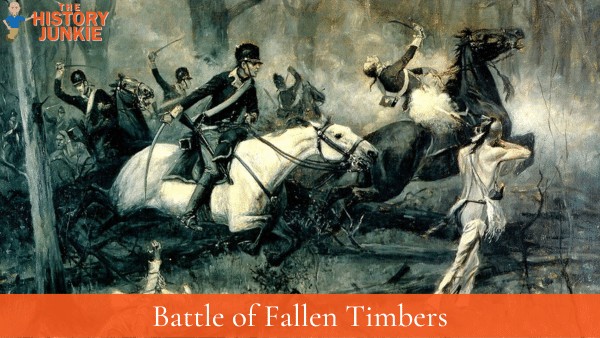
The Battle of Fallen Timbers was the final battle of the Northwest Indian War, which took place on August 20, 1794.
The battle was fought between the United States and a confederation of Native American tribes, including the Shawnee, Ottawa, and Wyandot.
The battle took place near the Maumee River in northwestern Ohio, near the present-day city of Maumee.
The battle was a decisive victory for the United States. The American forces, led by General Anthony Wayne, were able to defeat the Native American forces, led by Chief Blue Jacket.
The battle was brief, lasting only about an hour, but it had a significant impact on the course of the war.
The victory at Fallen Timbers effectively ended the Northwest Indian War. The Native American tribes were forced to sign the Treaty of Greenville in 1795, which ceded much of their land to the United States. The battle also marked the beginning of the westward expansion of the United States.
While the battle took place 11 years after the end of the Revolutionary War, it is often referred to as the last battle of the Revolutionary War.
